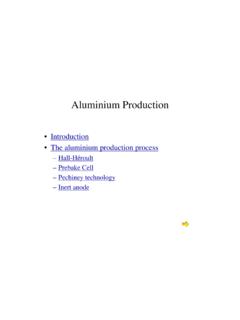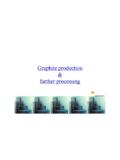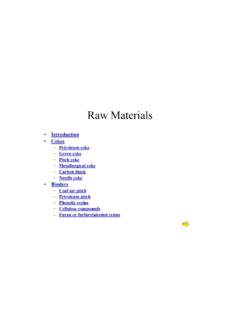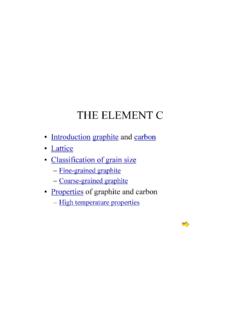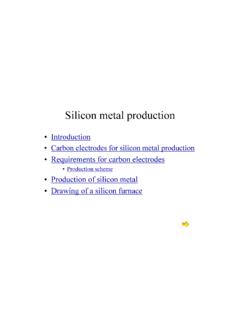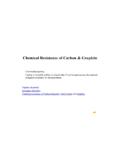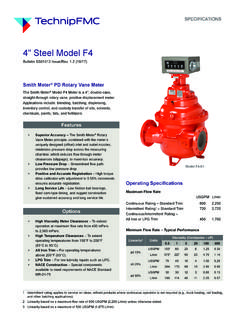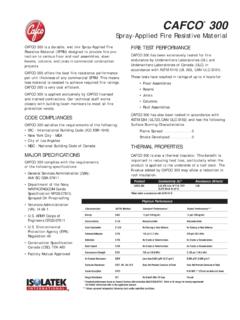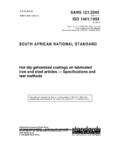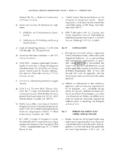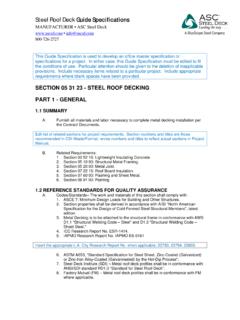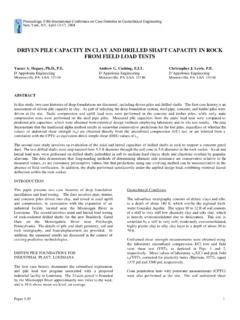Transcription of Steel part corrected - Carbon and Graphite
1 Steel production Furnace linings made from Carbon and Graphite are applied for the production of primary iron. Graphite electrodes and nipples (connecting pins) are applied for the production of Steel . Their production is similar to the Graphite production. After the baking process (for Carbon material) and/or the graphitization process (for Graphite ) the material is machined within well- defined tolerances on length and diameter. The nipples and sockets are threaded to assure optimal electrode- nipple your own Steel on-line!
2 Production process of ElectrodesSteel Production: intro Steel is one of the most important and widely used products in the world. Currently, the Steel industry is undergoing a process of change. As a result of ongoing technical and economic developments, the production and use of electric arc furnacesteel is, beneath the Steel production in a blast furnace, becoming increasingly important, continuously gaining share of world-wide Steel production over the past 30 years.
3 For the manufacture of Graphite electrodesfor the use in the EAF selected coal-tar or petrol cokes are crushed, milled and sieved to sort it by the specific different particle size fractions. Depending on the end use different fractions are mixed together with a liquid coal tar pitch as a binder. This mix is extruded into a green product with the near final shape and dimension of the resulting electrode. This rods are baked to 800 C - 1000 C and according to the needs for the final quality of the electrode impregnated with an petroleum pitch and rebaked.
4 Than the graphitisationstep follows where the material is graphitized by heating it up to 3000 C. 1900 1910 1920 1930 1940 1950 1960 1970 1980199219962000200401002003004005006007 008009001000 Share 2002:34% Steel Production in Mill. t Crude Steel Production in the WorldYear Total Steel Production Electric Steel ProductionCrude Steel Production in the WorldSource: IISI-StatisticsSteelmaking Process ChainRaw MaterialRaw MaterialMelting in anEAFS econdarySecondaryMetallurgyMetallurgy(LF )(LF)ContinuousContinuousCastingCastingR ollingRollingFinishedFinishedProductsPro ductsScrap metalDirect reduced iron DRIHot metalEAF ProcessElectric Arc Furnace (EAF)
5 Graphite ElectrodeScheme of an Electric Arc Furnace Electric Arc Furnace in useDue to different wear mechanismsthe length of the electrode is reduced during the process. In order to keep the arc (1) stable theheight of the electrode has to be readjusted continuously. Electrode RegulationRegulatorSETPOINTI mpedance Z = Usec/J1 Due to the different wear mechanismsthe electrode used in the EAF has to meet the following criteria:Requirements for Graphite Electrodes1.
6 Good electrical conductivity in order to withstand the high current densityrequired by the metallurgical process2. High thermal conductivity to minimise the temperature differences insidethe electrodes when in use and, consequently, to reduce internal stresses3. Low thermal expansion resulting in high thermal stress resistance4. Strength at high temperatures to withstand the stresses when in use5. Chemical inertness and non-wetting to glass and most metalsMaterial Parameter Graphite -Electrode (top performance 800mm) Carbon -Electrode (typical values) Apparent density g/cm3 g/cm3 Flexural Strength 10 14 N/mm2 4 7 N/mm2 Spez.
7 Electr. resistance m 22 36 m Coefficient of thermal expansion 10-6 K-1 10-6 K-1 O2O2O2O2O2CO2 COCOCOCOkAOnOff30 A /cm approx. CCCCCCC ontinuous WearDiscontinuous WearStub end LossElectrode Break: Nipple Socket Body LooseningSurface oxidationTipSublimationWear Mechanisms for an Electrode in UseNippleSocket breakBodyLoosening}The electrode Production:Mixing and ExtrusionBakingImpregnation and RebakingGraphitizationMachiningProductio n Process of Electrodescokeextrusionpitch-impregnatio nmixinggrindingbinder-pitchbakinggraphit izationmachiningGraphite ProductionMixing and ExtrusionThe milled coke (for Graphite electrode primary needle coke is used) is mixed with coal tar pitch and some additives to form a uniform paste.
8 This is brought into the extrusion cylinder. In a first step the air has to be removed by prepressing. Than the actual extrusion step follows where the mixture is extruded to form an electrode of the desired diameter and enable the mixing and especially the extrusion process (see picture on the right) the mixture has to be viscous. This is achieved by keeping it at elevated temperature of approx. 120 C (depending on the pitch) during the whole green production the water pondplugair12345 Scheme of the extrusion processBakingTwo types of baking furnaces are in use:Carbottom furnace:Here the extruded rods are placed in cylindrical stainless steelcanisters (saggers).
9 To avoid the deformation of the electrodes during the heating process the saggers are also filled with a protecting covering of sand. The saggers are loaded on railcar platforms (carbottoms) and rolled into natural gas- fired kilns. Ring furnace:Here the electrodes are placed in a stone covert cavity in the bottom of the production hall. This cavity is part of a ring system of more than 10 chambers. The chambers are connected together with a hotair circulation system to save energy.
10 The voids between the electrodes are also filled with sand to avoid the baking process, where the pitch is carbonised, the temperature has to be controlled carefully because at the temperatures up to 800 C a rapid gas build up can cause cracking of the in a ring furnaceImpregnation and RebakingDue to the outgasing during the baking process the electrode is porous with a low density. Therefore an impregnation step is added where the electrode is loaded with up to 13% of pitch, which is carbonised in another rebaking process in a carbottom furnaceBlast FurnaceFurnace linings made from Carbon and Graphite are applied for the production of primary iron.
